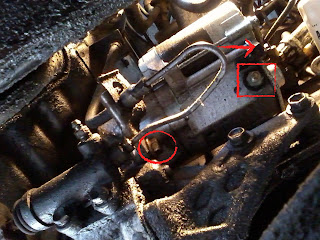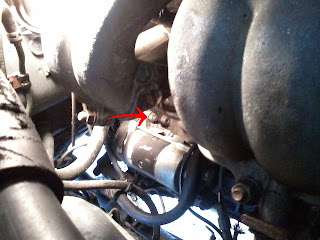I began with basic stuff, the "duh" steps. I made sure the battery posts were clean and that the positive start cable to the starter was tight. I pulled the solenoid wire slip out, cleaned both ends and used a pair of needle nose pliers to clamp down on the female receptacle to make sure the connection was tight. None of this worked. Still just a click.
So, even though I had already tried to jump start the truck and figured it wasn't the battery, it was the next easiest thing to check. I unplugged the battery and took it to PepBoys for a free battery test. The battery tested ok, albeit a little low on juice. Pep charged the battery, and I brought it home, but to no avail.
The next easiest piece to check was the starter. First, I did a solenoid check by short wiring the starter. To short wire the starter just take a small wire and touch one end to the positive wire (the fat wire that comes directly from the positive post on the battery) nut on the starter to the place where the solenoid wire plugs into the starter. If you're by yourself, make sure the truck is in neutral and the emergency break is on, and then turn the key to the on position. When I short started the starter, I could here the starter plunger fire, but the truck wasn't even trying to turn over. Just the "click" from the plunger firing.
I wasn't sure what to do at this point since it seemed that the starter was working, but in a last ditch effort before I resigned my truck to an electrical problem, I decided to remove the starter and take it to PepBoys for a free starter check. PepBoys did the check, and thankfully, it was the starter that was bad and not the coil or ignition switch or some hole in a wire that would be impossible to find. After replacing the starter, my truck started right up.
Removing the Starter:
TOOLS:
1. Socket Wrench
2. 13mm & 14 mm sockets
3. 3" socket extension.
STEPS:
1. First, remove the negative cable from the battery. This disconnects the entire electrical system.
 |
| 22re Starter: Solenoid Wire, Power, and Bottom Bolt |
3. Then, using the 13mm socket, remove the power wire from the starter. (For this step, I used two extension bars so my socket wrench was below the axle. A little overkill, but it made unscrewing the nut effortless.) (See square in pic).
4. Switch to the 14mm socket and the 3" socket extension and unscrew the bottom bolt from the starter. (This bolt also attaches the clutch slave cylinder to the transmission bell housing.)
5. Finally, still using the 14mm socket, remove the nut on top of the starter that bolts the part to the transmission.
 |
| 22re Starter Top Nut: view through EFI |
 |
| 22re Starter Top Nut: upper view from back of Engine |
6. After the final nut is removed, you'll need to slide back under the truck, pull the starter forward, and then maneuver it out.
Installing the Starter:
Installing the starter is basically the same steps as removal, just reversed.1. From under the truck, slide the new starter into position. The bolt on top of the starter holds it in place, so once the starter slides onto the bolt, you don't have to hold it anymore (thank you Toyota engineers!).
2. Once the starter is in place, screw in the bottom bolt.
3. Attach the Power cable.
4. Plug in the solenoid wire.
5. Then move to the top of the Engine compartment and screw the top nut back on.
Again, this is the most difficult part of the job because of the lack of access to the nut. I had to stand on a 5 gallon bucket in order to reach the bolt. I used my hand to get the nut on because it gave me greater control to feel the bolt; however, if you have a light shining down at the back of the engine as seen in the above picture, you can see what you're doing. After I got the nut on, I screwed the nut as tight as I could with my hand, then used the socket wrench to fasten it good 'n tight.
That's it.
How to Video:
I've created a video of the process to accompany the blog post. It's a tad long, but if you're the visual type:Choosing a Starter:
Refurbished starters are total crap. If you read through the starter forums on yotatech, or go to 4crawler.com, you'll find explanations for why. 4crawler also gives step by step instructions for rebuilding the starter as the stock starter is better than anything you can purchase at a local store. Rebuilding a starter is out of my league, so buying a new one was the only option for me. You can get a genuine OEM Toyota starter at the dealership, but they are a bit pricey. If you've got the time, you can find an original pulled starter for around $30 on eBay. If you purchase one at the local auto shop, they come with lifetime warranties. Keep the receipt because you'll need it. The refurbished / re-manufactured starter will go out every 2-3 years, if not sooner. I was in a desperate place, so I plunged for the refurbished crap starter. I figured replacing the starter was an easy enough job, so why not? Just hope the starter doesn't go out while I'm back on a trail!Share your own tips or horror story in the comments.